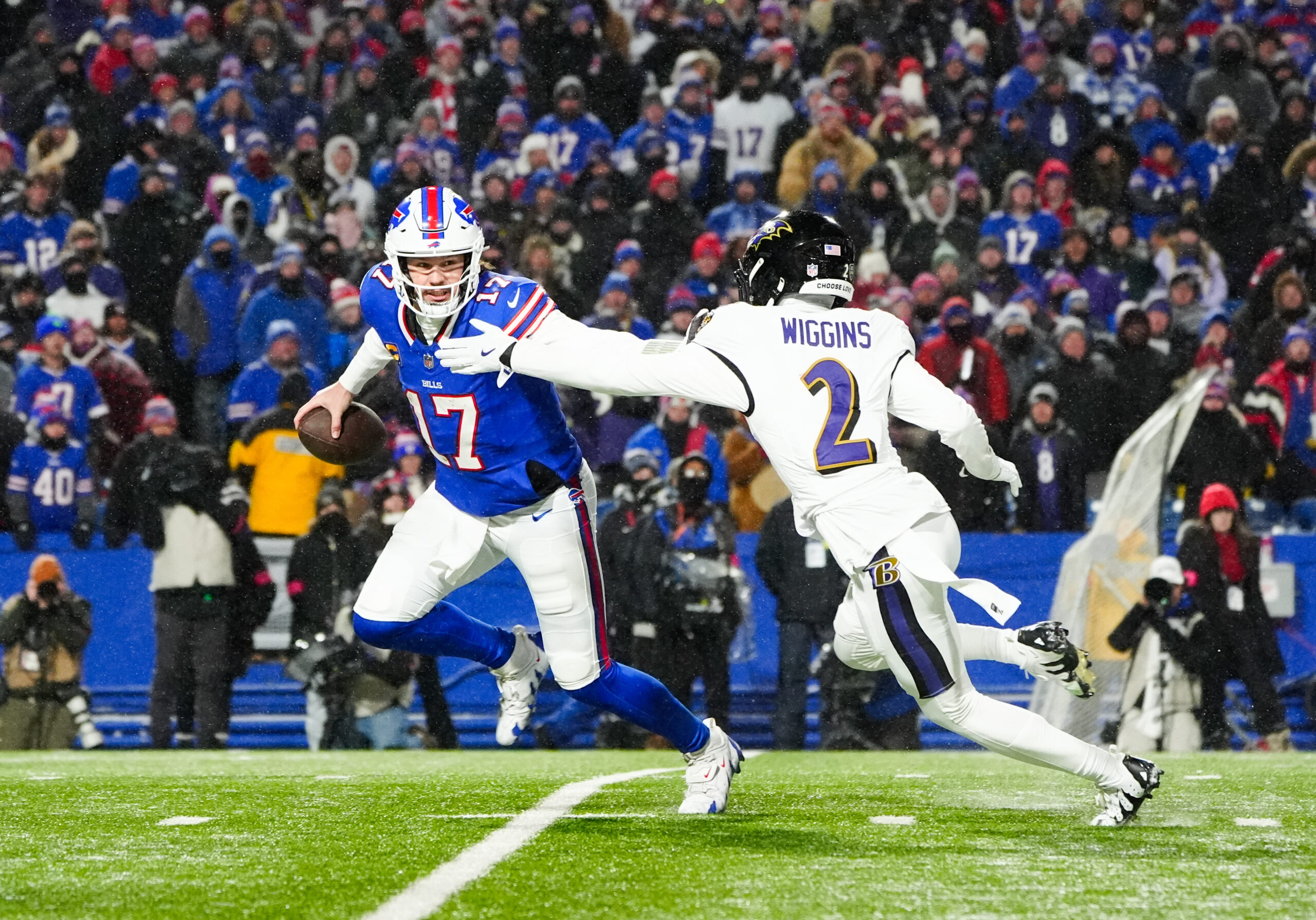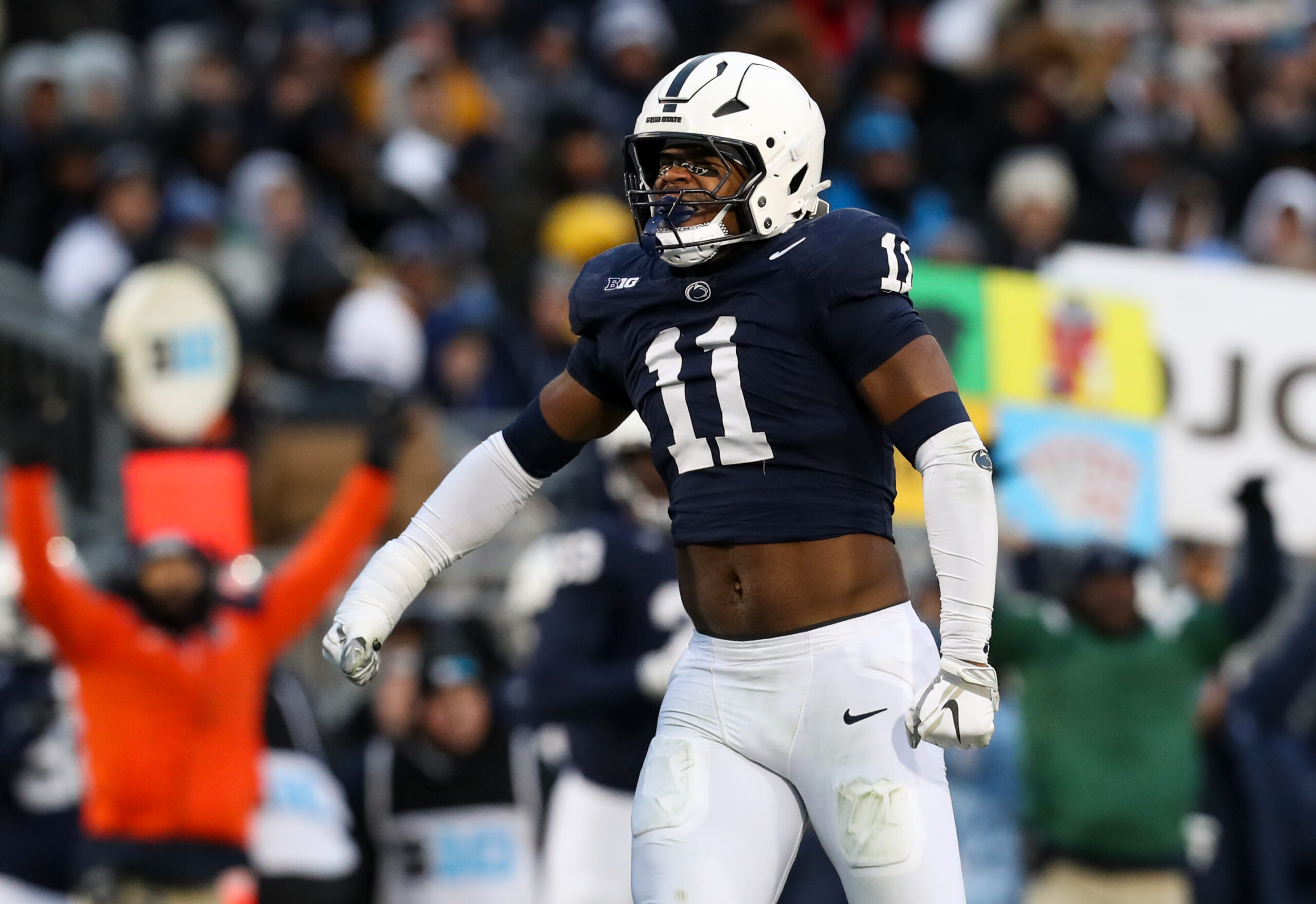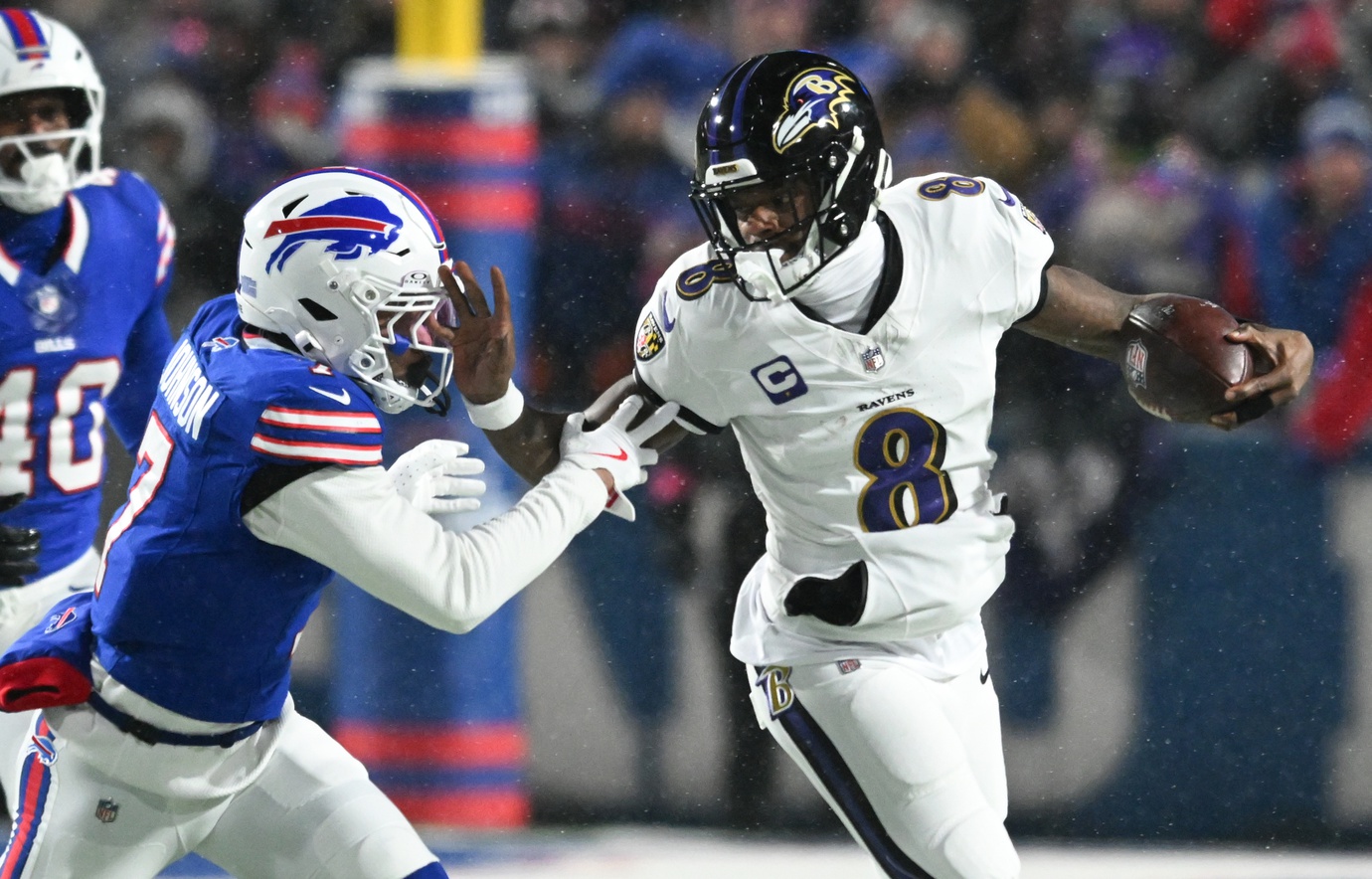NFL Analysis
11/11/24
23 min read
1st & 10 Week 10 2024: Lions & Chiefs Keep Winning, Cardinals As Contenders, Justin Herbert's Legs & More
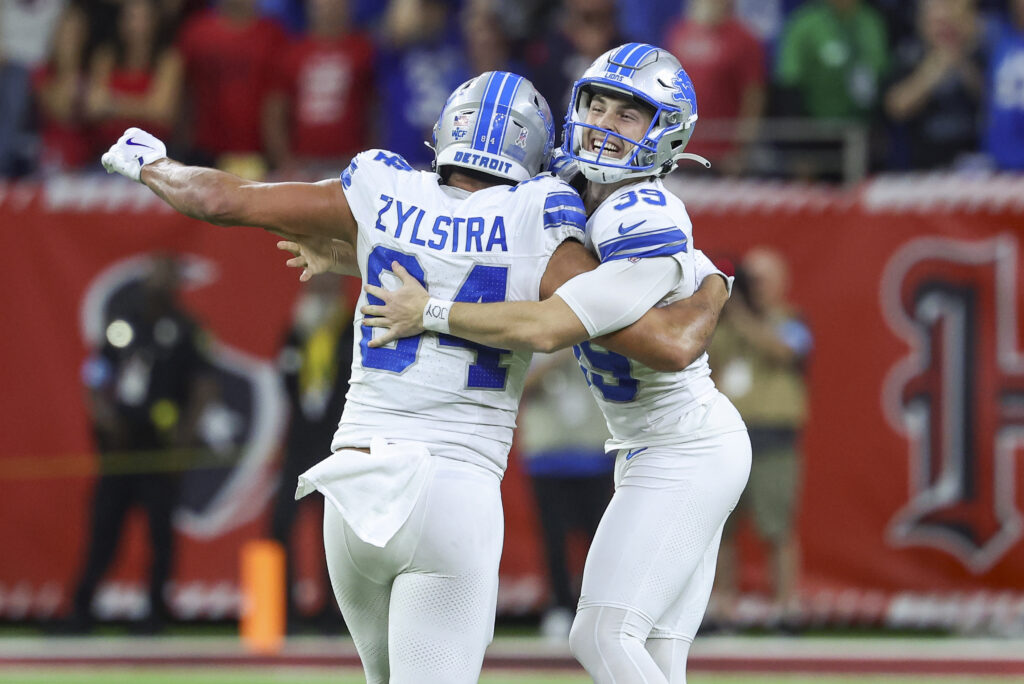
NFL Week 10 gave us a fun early slate with multiple games down the wire (forget about the international game), blowouts in the late afternoon, and a wild Sunday night game to cap everything off. Let’s get into what we can take away from Sunday’s action.
Each week, 1st & 10 will bring you a Monday morning an in-depth breakdown of everything you need to know from Sunday’s slate of games. We’ll fill this column with stats, film, and plenty of words to keep you covered on anything you might have missed or want to dive deeper into from Sunday.
All stats provided by TruMedia unless noted otherwise
1st & 10 NFL Week 10
1. This Texans-Lions Section Just Got Intercepted
The Detroit Lions cannot be killed. Things are going well, and the vibes are good when a star defensive player tweets out the text of Dan Campbell’s kneecap speech after the game.
Detroit escaped Houston with a 26-23 win, including five interceptions from Jared Goff and two field goals that barely scraped through the uprights. Yet a win is a win, and the Lions sit at 8-1 with the league’s best point differential (+113) and are in the driver’s seat for the top seed in the NFC.
This was easily the Lions’ worst offensive performance this season, and they still persevered. The first half was not good for Detroit, with Houston controlling the line of scrimmage on defense. The Lions averaged 3.8 yards per play in the first half, including just 1.8 yards per carry.
With a 25 percent rushing success rate, it was the second-worst half for the Lions this season, following a 20 percent success rate in the second half of the Week 4 game against the Seattle Seahawks. In that game, Goff went 18-of-18 as the Lions scored 42 points and only threw six times in the second half. They only rushed 10 times, excluding two Goff kneels.
But this was a game when the Lions tried to get a running game going early and couldn’t. That put Goff in passing situations, which led to pressure and bad throws. Goff had been good under pressure this season because that pressure came so infrequently. Through Week 9, he had a 41.5 percent success rate and 8.5 yards per attempt under pressure. However, against the Texans, Goff was 2-of-10 for 26 yards and just one of his interceptions under pressure.
Having that threat of pressure sped up some of Goff’s processes and led to some of the sprayed throws that became picks. Saying five interceptions might be overselling it a bit because one was a deep throw at the end of the first half, and another was more of a strip-sack that landed in a defender’s hands, but that doesn’t mean he played well.
The five interceptions in a win tie for second all-time behind George Blanda in 1962 and Frankie Sinkwich in 1944, each had six. In the modern game, Matt Ryan most recently won a game with five interceptions in Week 11 of 2012, and Tony Romo did it in Week 5 of 2007.
In the second half, the Lions settled down a bit and had more control of the game, both on the ground and through the air. Detroit went to more early down runs (52.2 percent in the first half to 63 percent in the second) and found success, which gave Goff more manageable passing looks.
That also led to more play-action, getting the ball out quicker, and having better pockets as the Texans pulled back on the blitz after halftime.

At the half, the Texans had an 86 percent win probability with a 23-7 lead, according to Next Gen Stats. Still, Houston was held scoreless in the second half with two interceptions, four punts, and a missed field goal. It was full of missed opportunities for the Texans.
One of the biggest was a could-have-been open touchdown targeting Tank Dell, but C.J. Stroud was moved off his spot and had to reset. While Dell looked wide open, Stroud lofted the pass, which gave time for Carlton Davis to undercut the throw for an interception.
On the broadcast angle, it looked as if Davis came from nowhere but Davis was on the route from the snap, even if he needed the lofted throw to catch up, and Stroud never saw him in the picture.
Carlton Davis end zone INT pic.twitter.com/4VB6fVEqa1
— Dan Pizzuta (@DanPizzuta) November 11, 2024
Throughout the game, the Texans continued to put Stroud in third-and-longs, relying on the quarterback to make a play to bail the offense out.
Houston had a 55.6 percent run rate on first down with a 5.9 percent success rate. That’s tied for the third-worst first down rushing success rate with at least 15 such carries in the past two seasons.

According to Next Gen Stats, Joe Mixon finished the game with the fifth-fewest rushing yards over expectation (-48) in the NGS era.
The Texans have failed to pivot away from the unsuccessful early-down runs and have put Stroud in unwinnable situations. This isn’t just complaining that early-down runs are inefficient — the Texans continually have the least successful runs in these scenarios, yet they continue to do the same things.
Stroud faced third-and-10 or more seven times on Sunday night and averaged 8.0 yards per attempt and 0.26 EPA per play. This season, Stroud has faced 50 plays of third-and-10 or more. That’s easily the highest figure in the league with the next-highest at 37.
Yet, Stroud ranks seventh in EPA per play and fourth in success rate. That’s just not a sustainable way to play offense.

When Stroud does drop back, he’s often pressured immediately. He was pressured 15 times and had a 20 percent success rate when pressured. He’s gotten a tendency to drift back in the pocket, expecting pressure, and that has made the sacks he takes worse.
Detroit's defense played excellent in the second half, forcing Stroud out of his comfort zone and bailing from clean pockets. Multiple players flashed on that side of the ball, but Brian Branch continued to make a huge impact.
Branch had two passes defensed, a quarterback hit, and a tackle for loss. He’s second among all defenders in Havoc plays (TFL, FF, PBU, INT, or Sack) with 18.
Even with the struggles in the second half, the Texans still had a chance to put the game away late in the fourth quarter. With the score tied at 23, Houston had a fourth-and-4 from the Detroit 40-yard line with 1:56 remaining.
The Texans decided to attempt a 58-yard field goal, which was missed. However, ESPN Analytics numbers suggest that going for it would have been a better option, requiring just a 45 percent conversion rate to justify it.

It’s hard to see Dan Campbell playing for a long field goal there (though they did settle for a 52-yarder for the game-winner on a third-and-7 as time expired), and being more aggressive could have at least kept the clock moving for an eventual field goal attempt.
Houston is still 6-4 and in control of the AFC South, but there isn’t a wide margin for error when this team plays better opponents. Detroit, meanwhile, just proved it could win while the quarterback literally tried to throw the game away.
That’s what the best teams can do, and the Lions are undoubtedly one of them this season.
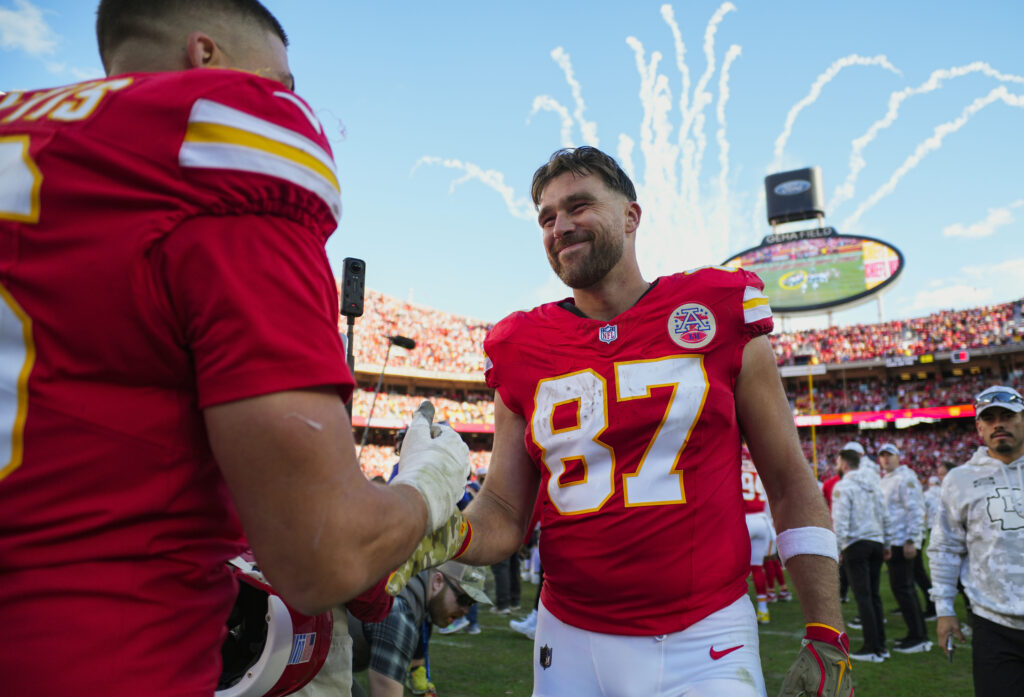
2. The Chiefs Keep Pulling Out Wins
The Kansas City Chiefs are 9-0. It hasn’t always looked pretty getting there, but there they are. After a 16-14 win, Kansas City is just one of five teams to go 9-0 following a Super Bowl win.
Regular-season success after a championship doesn’t mean that success will be sustained. Of the four prior teams to go at least 9-0 after a Super Bowl, three of the four didn’t make it back to the Super Bowl. It’s hard to sustain success, and the Chiefs might already be doing it in an unsustainable way.
The Chiefs had just a 34.8 percent offensive success rate against the Broncos in Week 10. Denver has put out a good defense this season — last week against the Ravens aside — so it’s not much of a surprise the defense played well, but it was also not the norm for the Kansas City offense.
For whatever the Chiefs offense has looked like this season, it’s been successful. They’re ninth in EPA per play but fifth in success rate. The explosives haven’t been there, but at its best, it’s been death by a thousand cuts.
However, if we look a bit closer overall, there’s a ton of reliance on Patrick Mahomes. The Chiefs are 10th in success rate on early downs while they’re 17th in EPA per play (-0.05) and last in explosive play rate (7.2 percent). On third down, the Chiefs are first in success rate, second in EPA per play, and sixth in explosive play rate.
That was the case against Denver in Week 10. Kansas City had a 28.6 percent success rate on early downs but a 44.4 percent success rate on third downs, while it did not run once, aside from three Mahomes scrambles.
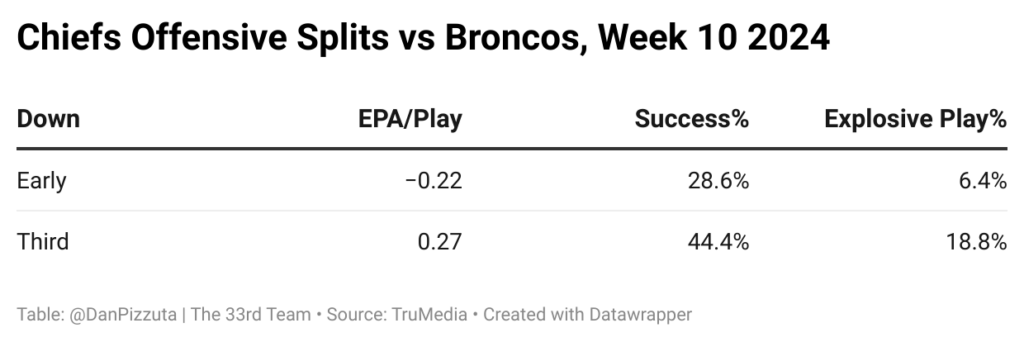
Kansas City averaged a third-and-7, and Mahomes converted three of five third-and-10s or longer.
This is kind of where the Chiefs are. They’ve gotten by without needing the big-play offense overall, and Mahomes has been able to become Patrick Mahomes on third downs and late in games. It shouldn’t be surprising that Mahomes has his best EPA per play (0.34) in the fourth quarter this season.
The Chiefs are still figuring things out on offense, as they’ve gone through lineup changes due to both additions and subtractions. Kansas City should eventually figure it out. Against the Broncos, the Chiefs took 50 percent of their drives into the red zone, yet just one of four trips resulted in a touchdown.
That touchdown was a fun design that got Travis Kelce open in space, tying Tony Gonzalez for the most touchdowns in franchise history at 76. Kansas City motioned Noah Gray into a tight bunch with Kelce and Justyn Ross (82).
Gray cut in to occupy the defenders in the middle of the field, and the deep defenders went with Ross. That allowed Kelce to start wide, draw the safety, and cut into open space for the score.
— Dan Pizzuta (@DanPizzuta) November 11, 2024
But the Chiefs have only scored a touchdown on 54.3 percent of their red zone trips this season (17th) despite having the fifth-highest rate of drives that reach the red zone (39.3 percent).
These lost opportunities leave the door open for a team like the Broncos to make some big plays and a chance to take the lead as time expires.
For the Chiefs, this hasn’t been all about the offense. The defense is still one of the league’s top units and held Denver to 14 points, even while Courtland Sutton got the better of Trent McDuffie a few times in coverage. The special teams unit came up big today with a block on the game-winning 35-yard attempt.
Kansas City is good. It's not dominant, but it has also found multiple avenues to win this season. That could be the biggest key to what the Chiefs look like at the end of the season. We’ve seen Mahomes turn it on when he needs to — as evidenced by this game — but if the Chiefs don’t always need him to, that could be how this sustains until February.
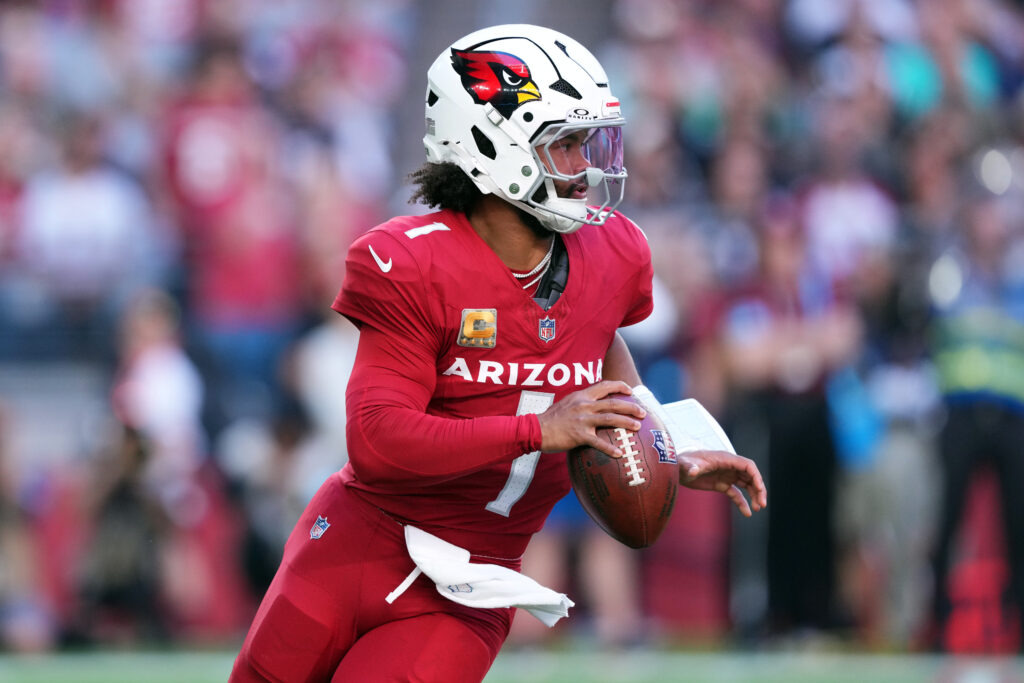
3. Are the Cardinals Actually Contenders?
The most surprising team this season might be the Arizona Cardinals. Arizona was a popular pick to be sneaky-fun among NFL Twitter, but they’re not quite sneaky anymore. After a 31-6 blowout win against the Jets, the Cardinals are 6-4 and alone in first place in the NFC West.
Arizona’s defense has been fun to watch. The unit constantly throws things at the wall in an attempt to compensate for the lack of top-tier talent.
Per MatchQuarters and Field Vision data, through the first nine weeks, the Cardinals were second in the rate of middle-of-the-field disguises (42.4 percent) and fourth in the rate of stunts on pass plays (32 percent). Arizona only ranked 24th in EPA per play on defense, but the picture was constantly changing, and it at least wasn’t making life simple for opposing offenses.
That defense sacked Aaron Rodgers three times and held the veteran to 4.3 yards per attempt, his worst figure with the Jets and the fourth-worst of his career.
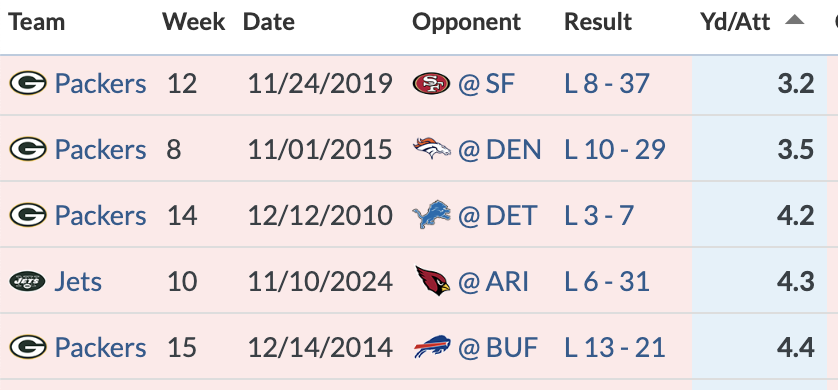
Having the defense come together could be a bonus for the Cardinals. Buddha Baker has been all over the field and second-year third-round pick Garrett Williams had an impressive day at cornerback. New edge rusher Baron Browning only played 16 snaps but had two pressures. This could be a unit finding its groove.
However, the offense, with Kyler Murray leading the way, is the best part of this Cardinals team. Against the Jets, Murray went 22-of-24 for 11.1 yards per attempt and a 95.9 QBR. Murray completed his last 17 passes in a row before he was taken out of the game.
There has been full control from Murray of late, especially under pressure. Murray was 7-of-7 under pressure against the Jets and averaged 1.06 EPA per dropback. He now leads all quarterbacks in EPA per play under pressure for the season. He’s second in success rate and completion percentage behind Tua Tagovailoa, who has missed multiple games and has far fewer plays under pressure this year.
Then, there’s always the threat of Murray’s legs.
In the past three weeks, Murray is third in EPA per play and leads all quarterbacks in success rate.
The Cardinals are figuring out the best ways to use the players in their offense, and the execution has matched the creativity. Take the 44-yard catch from James Conner on the first drive of the game.
Arizona motioned Greg Dortch into the backfield with Conner. Dorth ran orbit motion after the snap and pulled the defense with him. That left just one defender and two blockers on the left side of the field for Conner.
Cardinals motion Greg Dortch into the backfield, linebackers flow with him post-snap, leaves an open side of the field for James Conner pic.twitter.com/hCLljG3VwQ
— Dan Pizzuta (@DanPizzuta) November 11, 2024
Arizona scored on its opening drive, as the team has on 60 percent of them this season. That’s the best rate in the league. On opening drives this season, the Cardinals have averaged 2.23 EPA and 4.2 points per drive. All of those figures lead the league.
The Cardinals have also gotten better at adapting mid-game and controlling the situational play. Arizona has leaned into heavier personnel and has still run successfully from it. Trey McBride has become a top-tier tight end, adding 71 yards on four catches in this game.
Marvin Harrison Jr.’s usage has also improved from the start of the season. He had a slot fade for a touchdown with Conner on the outside, which forced the Jets to figure out who would stay with who in coverage, as D.J. Reed was originally on the outside but kicked inside once Conner motioned out.
The Cardinals might not overwhelm opponents — though a blowout against the Jets begs to differ — but this is a team with one really good unit. That could be enough to be a frisky team late in the season. Arizona already has wins against the 49ers and the Rams, and we might not have seen the best version of this team just yet.
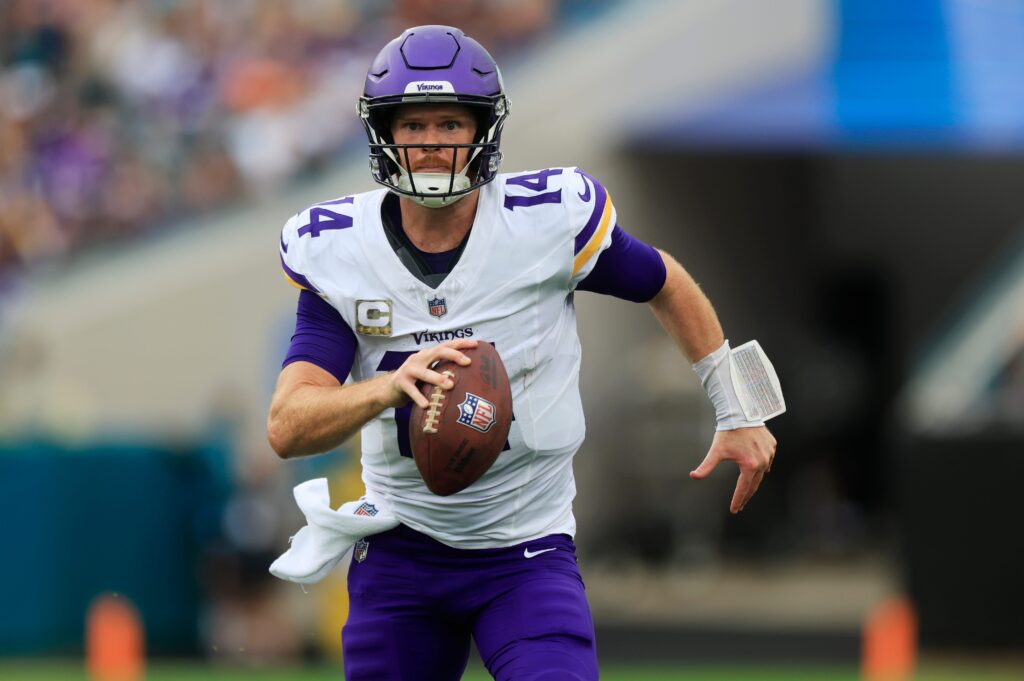
4. Will Sam Darnold Hold The Vikings Back?
Getting away with some of Sam Darnold’s risky throws was easier at the start of the season when there were one or two a game, and the Minnesota Vikings had big leads. It’s become harder as the dangerous throws have become more frequent, and the games have been closer.
Darnold threw three interceptions and could have thrown more in a 12-7 win against the Jacksonville Jaguars. If the Jaguars were starting a quarterback other than Mac Jones, this could have been a game that got away from the Vikings. As it was, Jacksonville scored zero points off turnovers and could not cross the goal line in general.
However, the focus is on Darnold, who has five interceptions in the past two weeks in close wins against Jacksonville and Indianapolis. These are not the types of games Minnesota should be having.
But, there is a bright spot. Even with the higher interception rates, these games aren’t far off from the ones Darnold was having earlier in the year. Despite the picks and averaging -0.12 EPA per play against the Jaguars, Darnold still had a 45.7 percent success rate, which was the 11th-highest of the week.
There are still the easy buttons in this offense, and Darnold is hitting them. It’s not a total collapse where Darnold is forcing these bad throws and falling apart elsewhere in the passing offense.
With the return of T.J. Hockenson, there’s even another safety net for Darnold in the passing game. Against the Jaguars, the Vikings used a season-low 48.8 percent of 11 personnel. They went to 12 personnel 29.3 percent of the time and used 21 on 15.9 percent of plays.
As a result, a season-high 39.5 percent of Darnold’s targets went to tight ends. On 15 throws to tight ends, Darnold averaged 0.65 EPA per play with a 60 percent success rate. With the heavier personnel, the Jaguars matched with base on 51.2 percent of snaps, easily their highest rate on the season.
It’s another avenue to get Darnold to throw easier throws to the middle of the field. If it keeps defenses in heavier personnel to match, it’ll eventually open up more on the outside for Justin Jefferson and Jordan Addison.
The answers remain there, even when Darnold is turning the ball over. It keeps the ceiling high, and as long as the floor doesn’t completely bottom out, the Vikings should be OK.
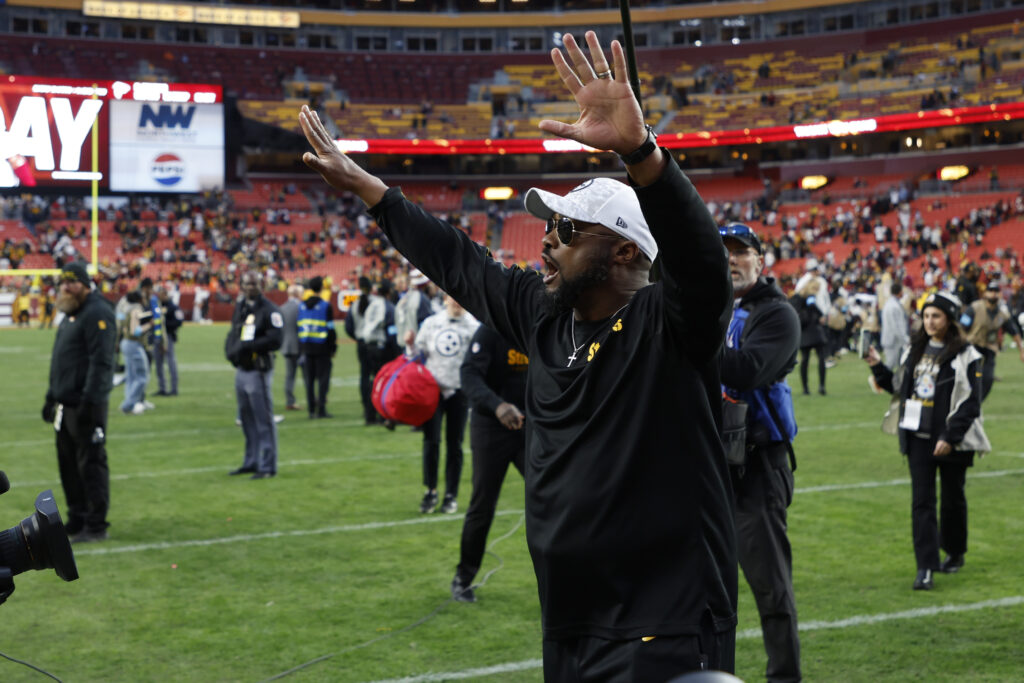
5. Steelers Get Past Commanders
Steelers-Commanders was not supposed to be one of the most anticipated games of Week 10 when the season started, and a 28-27 Pittsburgh Steelers win certainly delivered.
The Steelers lead the AFC North and have become a different team with Russell Wilson at quarterback. This is not the peak Wilson of the Seahawks years, but more importantly, this hasn’t been Broncos Wilson, either. Wilson has had just enough control of the offense to keep it on schedule, and the deep throws (his patented moon ball) have raised the offense's ceiling.
There might not be a quarterback-wide receiver pairing that matches each other’s freak more than Wilson and George Pickens. Wilson can throw the ball up, and Pickens is a master at adjusting his body and making circus catches, as he did on a touchdown in the first quarter.
The Steelers also added a run-deep-and-adjust-to-the-ball receiver in Mike Williams, who had a deep touchdown that gave the Steelers the lead late in his debut.
These are skill sets that fit together. Wilson is first in EPA per play on throws of 20 or more air yards, and the Steelers will ride with that as long as it works. Wilson only had a 37 percent success rate against Washington, but the big plays hit.
Couple that with a defense that has made life difficult for opposing offenses, and this becomes a team to worry about.
Jayden Daniels had some nice plays against Pittsburgh, but the Steelers mostly contained the rookie. That comes somewhat literally. Pittsburgh has been great at defending opposing quarterback runs, and Daniels had just three carries for five yards. Just 5.4 percent of Daniels’s plays came outside the pocket.
When Daniels tried to extend plays, options weren’t there. On throws of 2.5 seconds or more, Daniels completed 5-of-16 passes for 46 yards with a 15.8 percent success rate.
The Steelers also forced him to throw into tight windows. His 20.6 percent rate of throws into a tight window (defined as a yard or fewer of separation per Next Gen Stats) was his second-highest of the season behind the 28.6 percent rate against Baltimore, two of Washington’s three losses.

6. CMC’s Return
If you want to see the margin for error Christian McCaffrey provides the San Francisco offense, look at his 30-yard reception in the fourth quarter.
McCaffrey ran a wheel with a little hesitation move out of the backfield. With immediate pressure, Brock Purdy had to release the ball while fading away. Trusting McCaffrey would get open, Purdy floated it up to a spot down the sideline, and McCaffrey ended up under it.
That’s just not a play available with another back in that spot. In his return to the lineup, McCaffrey played 88.5 percent of the offensive snaps. He caught six passes for 68 yards and rushed 13 times for 39 yards for 107 total yards in his 2024 debut.
The offense looked better with McCaffrey, but he didn’t immediately fix all of the issues. San Francisco only converted one of three red zone trips into a touchdown, and that required a bananas connection between Purdy and George Kittle in the corner of the end zone.
Kittle initially had 1-on-1 coverage because three defenders were worried about McCaffrey.
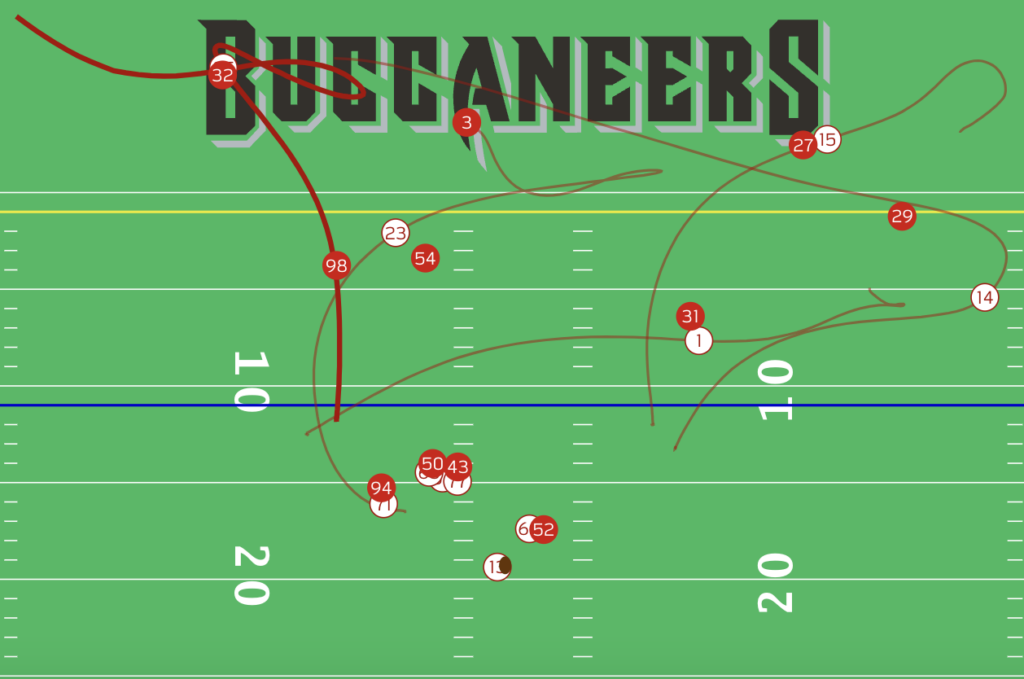
Purdy did finish with a 58.1 percent success rate, his highest of the season, which was aided by the running back’s presence. The gravity was instant. There were more Shanahan staples throughout the game, targeting the middle of the field, even though Purdy’s play-action rate was just above 11 percent.
Three missed field goals made this game closer than it should have been, with the 49ers needing a walk-off 44-yarder for the 23-20 win against the Buccaneers. Even with McCaffrey, San Francisco didn’t look like the 2023 offensive juggernaut, but they have the second half of the season to figure that out.
Given how weird things have been in San Fransisco this season, we’ll see if they can.

7. Drake Maye vs. Caleb Williams
When Caleb Williams and Jayden Daniels played in Week 8, it was an entertaining game that showed some of the best traits from the two rookies with a wild Hail Mary finish. This meeting between Williams and Drake Maye was not that.
The Patriots easily handled the Bears in a 19-3 win. Maye continues to progress and has made the most of an unideal situation for a rookie quarterback, while Williams has regressed back to the early season state since the Washington game.
Williams averaged -0.54 EPA per play with a 28.3 percent success rate. The first-overall pick again looks overwhelmed by interior pressure and a lack of easy answers in the offense. Williams was sacked nine times with 18 pressures, per Next Gen Stats.
Meanwhile, Maye has done enough to steady himself, even when the big numbers haven’t come. He’s shown comfort and the ability to extend plays when things go wrong without panicking.
Williams and Maye had rough starts but improved quickly with more time. As you can see by the success rate of the two rookies, Maye has sustained that rate while Williams has dropped back down.
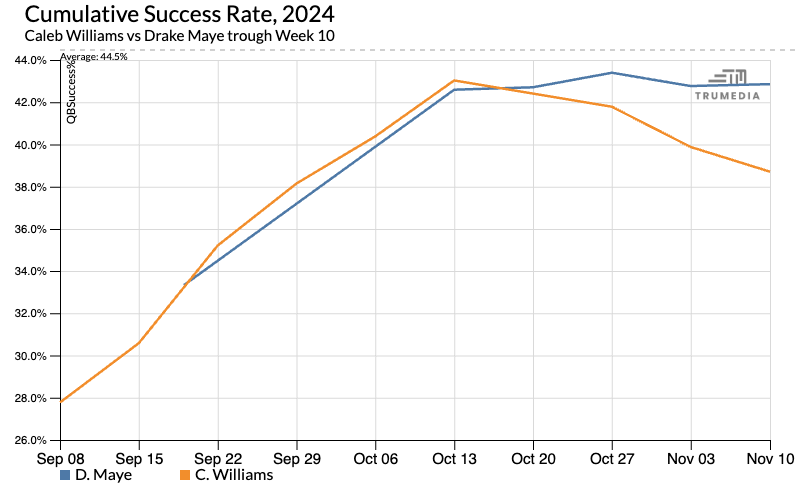
The Bears did not expect to be in this position with Williams, especially after his progression in Weeks 4-6.
With the loss and the consistent struggles with the offensive scheme, coaching changes could be coming in Chicago with the hope of fixing things before they get worse.
8. Chart of the day

The Panthers signed Chuba Hubbard to a four-year, $33.2 million contract extension last week, and he was the best player for Carolina in a 20-17 overtime win against the Giants in Germany.
Hubbard ran for 153 yards, averaging 0.17 EPA per rush with a 42.9 percent success rate, per TruMedia. He had nine forced missed tackles and 71 yards over expectation, per Next Gen Stats. He thrived on outside runs, where the Giants have struggled this season. Hubbard had 10 carries for 87 yards to the outside.
9. Play of the day
The Falcons lost to the Saints, but during that game, Bijan Robinson had an impressive 37-yard touchdown run that showed why he’s a special back and why Atlanta has one of the league’s best run games this season.
Robinson was hit two yards beyond the line of scrimmage and bounced off a tackle. That would be impressive enough. But Robinson slipped after breaking the tackle and still had the acceleration to get past Tyrann Mathieu and take the ball into the end zone.
Among 26 running backs with at least 100 carries this season, Robinson is third in success rate (46.5 percent). That’s come without many of the explosives that Robinson could bring to this offense. With runs like this (it was a season-long), the Falcons could be an even bigger threat on the ground during the second half of the season.

10. Justin Herbert Did It Himself
This was the Justin Herbert game.
Herbert has been playing great during the past few weeks, but there’s been something just off that the numbers didn’t match. It looked like we could have been in store for another version of that this week when a potentially incredible touchdown throw was dropped.
However, that wasn’t the case. Herbert finished the game with 0.51 EPA per play and a 51.9 percent success rate. That’s his fourth-best game by EPA per play in his career.
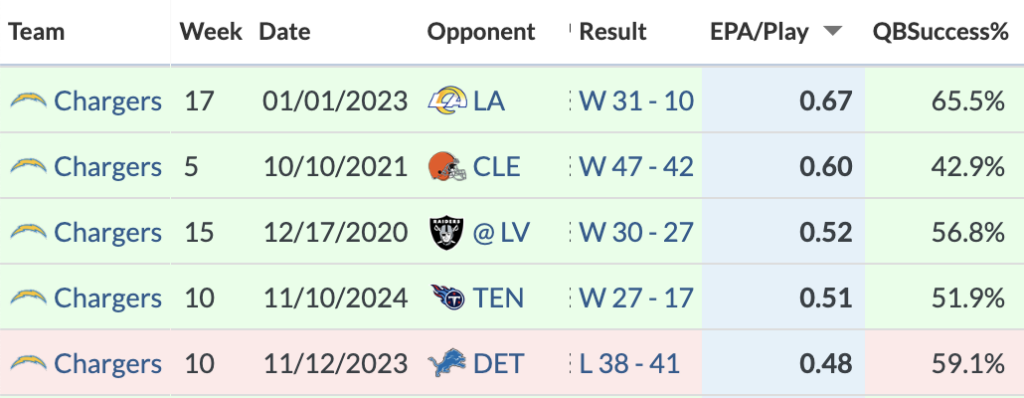
Herbert embarrassed Tennessee defenders, making them fall down on pump fakes…
…getting juked in the open field…
…and he even scored a touchdown on a designed run.
Herbert had been playing great football, but the offense around him was not playing up to his level. It matched him enough this week, even though he could have done most of it by himself.
If Herbert can consistently make those types of plays on the move, extending and creating, this could open up a whole new world for the Chargers offense and Herbert’s production going forward. More of this would make the Chargers — currently 6–3 — a legitimate threat down the stretch.

